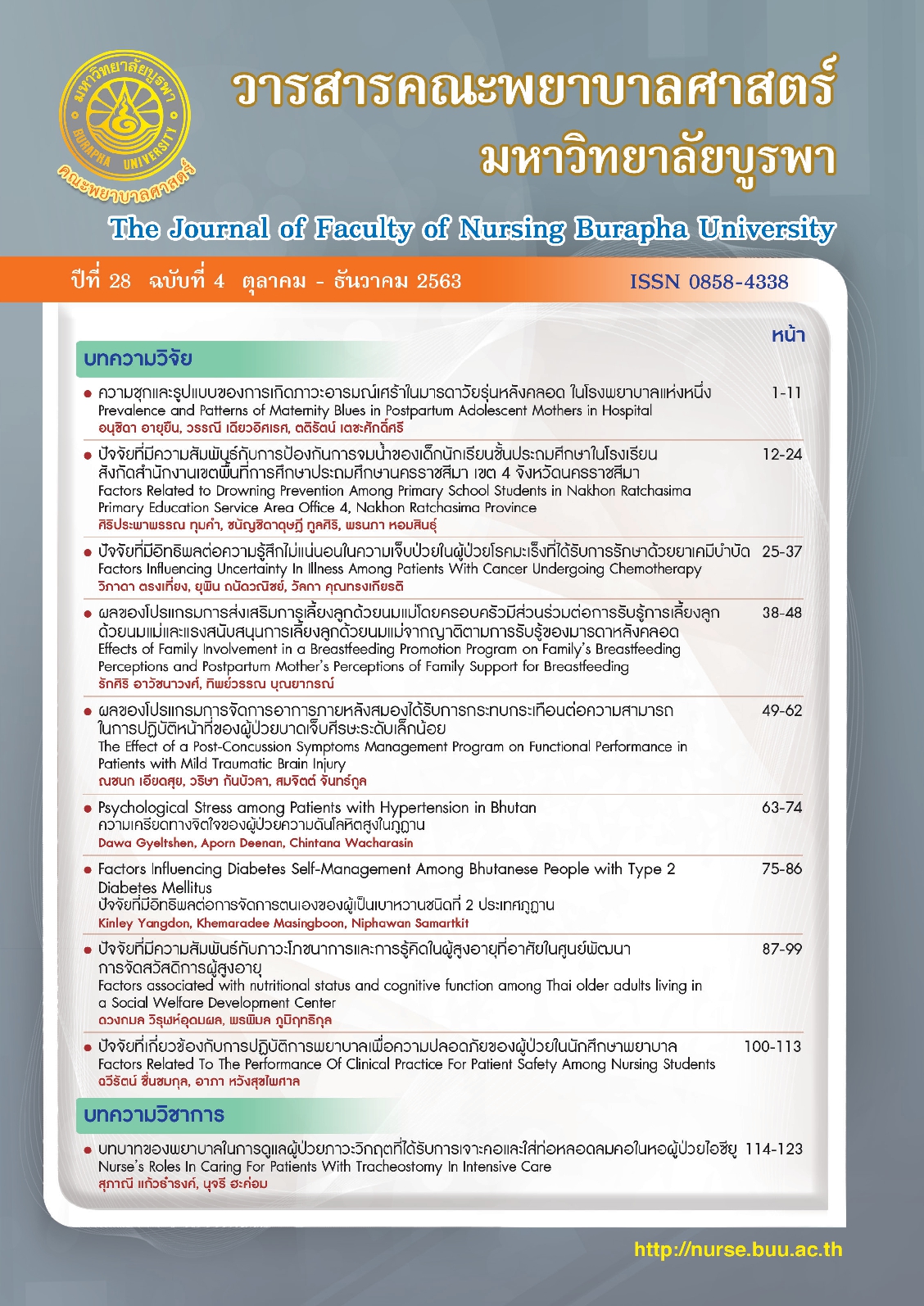ปัจจัยที่มีความสัมพันธ์กับการป้องกันการจมน้ำของเด็กนักเรียน ชั้นประถมศึกษาในโรงเรียนสังกัดสำนักงานเขตพื้นที่การศึกษาประถมศึกษานครราชสีมา เขต 4 จังหวัดนครราชสีมา
คำสำคัญ:
ความสามารถในการตัดสินใจ, การป้องกันการจมน้ำ, เด็กนักเรียนชั้นประถมศึกษาบทคัดย่อ
การวิจัยครั้งนี้มีวัตถุประสงค์เพื่อศึกษาปัจจัยที่มีความสัมพันธ์กับการป้องกันการจมน้ำของเด็กนักเรียนชั้นประถมศึกษาในโรงเรียนสังกัดสำนักงานเขตพื้นที่การศึกษาประถมศึกษานครราชสีมาเขต 4 จังหวัดนครราชสีมา กลุ่มตัวอย่าง ได้แก่ เด็กนักเรียนชั้นประถมศึกษาในโรงเรียนสังกัดสำนักงานเขตพื้นที่การศึกษาประถมศึกษานครราชสีมาเขต 4 จำนวน 245 คน ซึ่งได้มาจากการสุ่มตัวอย่างแบบหลายขั้นตอน เครื่องมือที่ใช้ในการเก็บรวบรวมข้อมูลประกอบด้วย แบบสัมภาษณ์ข้อมูลส่วนบุคคล ความรู้เกี่ยวกับการป้องกันการจมน้ำ ความสามารถในการตัดสินใจเพื่อป้องกันการจมน้ำ การรับรู้ความเสี่ยงต่อการจมน้ำ สิ่งแวดล้อมทางกายภาพ การสนับสนุนจากครอบครัวเพื่อป้องกันการจมน้ำ การป้องกันการจมน้ำ วิเคราะห์ข้อมูลโดยสถิติเชิงพรรณนา สัมประสิทธิ์สหสัมพันธ์พอยท์ไบซีเรียล และสัมประสิทธิ์สหสัมพันธ์ของเพียร์สัน
ผลการวิจัยพบว่า กลุ่มตัวอย่างมีคะแนนเฉลี่ยการป้องกันการจมน้ำในระดับปานกลาง (M = 22.27, SD = 3.88) และปัจจัยที่มีความสัมพันธ์กับการป้องกันการจมน้ำของเด็กนักเรียนชั้นประถมศึกษาอย่างมีนัยสำคัญทางสถิติ ได้แก่ ความสามารถในการตัดสินใจเพื่อป้องกันการจมน้ำ (r = .898, p <.001) สิ่งแวดล้อมทางกายภาพ (r = .178, p <.01) การรับรู้ความเสี่ยงต่อการจมน้ำ (r = .174, p <.01) การสนับสนุนจากครอบครัวเพื่อป้องกันการจมน้ำ (r = .162, p <.05) ส่วนความรู้เกี่ยวกับการป้องกันการจมน้ำ และเพศ ไม่มีความสัมพันธ์กับการป้องกันการจมน้ำในเด็กนักเรียนชั้นประถมศึกษาอย่างมีนัยสำคัญทางสถิติ จากผลการวิจัยมีข้อเสนอแนะว่า พยาบาลหรือบุคลากรทางสุขภาพควรนำผลการวิจัยไปใช้เป็นแนวทางในการพัฒนากิจกรรม/โปรแกรมเพื่อการป้องกันการจมน้ำในเด็กนักเรียนชั้นประถมศึกษา โดยเน้นเสริมสร้างศักยภาพการตัดสินใจ การจัดสิ่งแวดล้อมทางกายภาพ การรับรู้ความเสี่ยง และการสนับสนุนจากครอบครัวเพื่อการป้องกันการจมน้ำ
เอกสารอ้างอิง
among school-age children, Northeastern region. Journal of Nursing
Science Chulalongkorn University, 27(2), 72-84. [In Thai]
Chiangkraiwet, P., Kanthanut, M., & Paunprathom, N. (2013). Pediatric trauma.
Songkha: Chanmuang press.
Chivanon, N. (2016). Accidents in children: Situation and prevention. The Journal of
Faculty of Nursing Burapha Universit, 24(3), 1-12. [In Thai]
Cortés, L. M., Hargarten, S. W., & Hennes, H. M. (2006). Recommendations for water
safety and drowning prevention for travelers. Journal of Travel Medicine,
13(1), 21-34.
Division of Non Communicable Diseases. (2019). Drowning prevention plan 2019.
Retrieved from http://www.thaincd.com/document/file/drowning. [In Thai]
Division of Non Communicable Disease. (2020). Significant issues for the 2020 child
drowning prevention campaign. Retrieved from http://www.thaincd.com/
2016/mission4?tid=37 [In Thai]
Division of Non Communicable Diseases (Preventing Injury Groups from Other Causes)
Department of Disease Control. (2018). Significant issues for the 2018 child
drowning prevention campaign. Retrieved from http://moungkham.go.th/
fileupload/files/tb_files_48_1.pdf [In Thai]
Erikson, E. H. (1963). Childhood and society (2nd Ed.). New York: Norton.
Green, L. W., & Kreuter, M. W. (2005). Health program planning: An educational and
ecological approach (4th ed.). New York: McGraw-Hill Higher Education.
Hossain, M., Mani, K. K., Sidik, S. M., Hayati, K. S., & Rahman, A. K. (2015). Randomized
controlled trial on drowning prevention for parents with children aged
below five years in Bangladesh: A study protocol. BioMed Central Public
Health, 15(484), 1-7. doi: 10.1186/s12889-015-1823-1.
Kaewviengdach, C., & Hirunwatthanaku, P. (2016). Factors associated with sexual risk
behaviours among secondary school students in Nakhon Phanom province.
Journal of The Royal Thai Army Nurses, 17(3), 168-177. [In Thai]
Kasonbua, P., Nabkasorn, C., & Hengudomsub, P. (2016). Effect of humor media
program on fear of school-age children receiving intravenous infusion.
Journal of Faculty of Nursing Burapha University, 24(2), 61-71. [In Thai]
Little, R. J. A., & Rubin, D. B. (2002). Statistical analysis with missing data (2nd ed.).
New York: John Wiley & Sons.
Nakhon Ratchasima Primary Education Service Area Office 4, 2018. (2018). Student
information. Retrieved from https://data.bopp-obec.info/emis/
student.php?Area_CODE=3004&Edu_year=2562.
Polit, D. F., & Beck, C. T. (2017). Nursing research: Generating and assessing evidence
for nursing practice (10th ed.). Philadelphia: Lippincott Williams & Wilkins.
Salee, K., Chaimongkol, N., & Pongjaturawit, Y. (2015). Predictors of health risk
behaviors in late school-age children. The 6th National and International
Conference, 1(6), 54-64. Retrieved from http://journalgrad.ssru.ac.th/index.
php/5-01/issue/view/52 [In Thai]
Saroung, Y., Durongritichai, W., & Kompayak, J. (2014). The development of health
partnership for injury prevention of school-aged children in community,
Journal of Public Health Nursing, 28(2), 39-50. [In Thai]
Schyllander, J., Janson, S., Nyberg, C., Eriksson, U. B., & Stark Ekman, D. (2013). Case
analyses of all children’s drowning deaths occurring in Sweden 1998-
2007. Scandinavian Journal of Public Health, 41(2), 174-179.
Strategy and Planing Division, Office of the Permanent Secretary. (2018). Twenty-year
national strategic plan for public health. Bangkok: The War Veterans
Organization of Thailand Under Royal Patronage of His Majesty the King.
Suwantip, N., & Witthayawirasak, B. (2018). Using participatory action research for
injury prevention in child development centers, Suratthani province.
Kasetsart Journal of Social Sciences, 39(2018), 98-104. [In Thai]
Taskesen, M., Pirinccioglu, A. G., & Yaramis, A. (2015). Drowning and near-drowning in
children in the southeast of Turkey. The Journal of Academic Emergency
Medicine, 14(2), 16-25.
Tyler, M. D., Richards, D. B., Reske-Nielsen, C., Saghafi, O., Morse, E. A., Carey, R., &
Jacquet, G. A. (2017). The epidemiology of drowning in low-and middle-
income countries: A systematic review. BioMed Central Public Health,
17(413), 1-7.Retrieved from https://ulsafetyindex.org/library/the-
epidemiology-of-drowning-in-low-and-middle-income-countries-a-
systematic-review.pdf
Veetil, J. N., Parambath, V. A., Rajanbabu, B., & Suresh, S. (2017). An epidemiological
study of drowning survivors among school children. Journal of Family
Medicine and Primary Care, 6(4), 844-847. doi: 10.4103/jfmpc.jfmpc_349_16
White, K. M., Zhao, X., Hyde, M. K., & Hamilton, K. (2018). Surviving the swim:
Psychosocial influences on pool owners’ safety compliance and child
supervision behaviours. Safety Science, 106(2018), 176-183.
Willcox-Pidgeon, S., Kool, B., & Moran, K. (2018). Perceptions of the risk of drowning at
Surf beaches among New Zealand youth. International Journal of Injury
Control and Safety Promotion, 25(4), 365-371.
World Health Organization [WHO]. (2018). Global drowning report 2018. Geneva:
World Health Organization. Retrieved from https://apps.who.int/iris/bi
tstream/handle/10665/272596/9789241565585-eng.pdf





